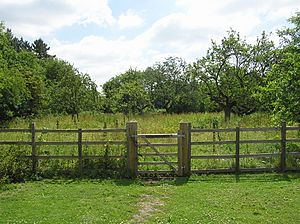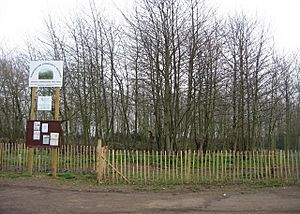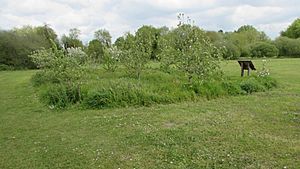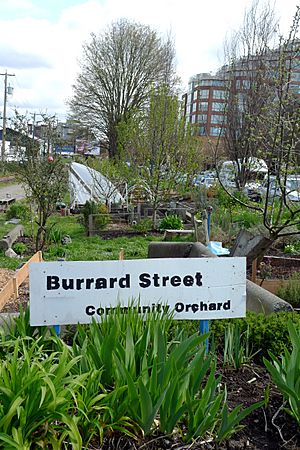Community orchard facts for kids
A community orchard is a special place where fruit trees grow. These trees are shared by everyone in a community. You can often find them in public parks, school grounds, or even churchyards. Unlike regular farms, community orchards are not for making money. Instead, they are cared for by a group of people who volunteer their time.
People plant community orchards for many good reasons. They help more people get healthy, organic fruit. This is especially helpful in areas where fresh food might be hard to find or too expensive. Orchards also teach young people where their food comes from. They help people learn how to grow fruit trees. Plus, an orchard can turn a simple park into a lively community hub. People volunteer together to care for the trees and pick the fruit. Many groups also hold fun events like harvest festivals or cider-making workshops.
Contents
Different Kinds of Community Orchards
Community orchards can be set up in different ways. Each type helps people enjoy fresh fruit and work together.
Orchards with Memberships
Some community orchards work like a club. For example, the Copley Orchard in Vancouver has a membership plan. Members might pay a small yearly fee. This money helps cover the orchard's costs. In return, members get to enjoy the fruit. They also have a responsibility to help care for the trees during special work days.
Orchards in Community Gardens
Other orchards are part of larger community gardens. The Strathcona Community Orchard in Vancouver, B.C., is a good example. People pay a small fee to grow vegetables or flowers in their own garden plot. As part of their membership, they also help care for the shared areas. This includes the fruit trees, the compost pile, and the pathways. They usually have to attend a few work parties each year.
Saving Old Orchards
Not all community orchards are newly planted. Sometimes, people work together to save an old orchard that has been forgotten. These old orchards might otherwise be cut down. The Piper Orchard in Seattle, Washington, is one such example. It was planted a long time ago in the late 1800s. The land later became a city park. For many years, the fruit trees were forgotten. Then, in 1983, volunteers cleared the overgrown plants. They found many trees were still alive and producing fruit!
Nature-Friendly Orchards (Permaculture)
Some groups are creating "food forests" in their orchards. This idea is called permaculture. It means planting different kinds of food plants together. The goal is to create a natural system that works like a forest. In these food forests, trees, shrubs, and herbs grow side-by-side. They help each other by preventing pests and making the soil healthier. The Beacon Food Forest in Seattle is a famous example of this type of orchard.
City Planning and Orchards
Cities are also starting to plant fruit trees in public spaces. They see how much people want shared fruit trees. For instance, the City of Calgary started a project in 2009. Some of their orchards are run by the city, and others by the community. Their goals include growing local food and getting people involved. They also want to teach people how to care for fruit trees. This helps them learn what works best for community orchards.
Why Community Orchards Are Great
Researchers are studying how community orchards help cities. They look at how orchards affect food security and the environment. Food security means making sure everyone has enough healthy food. Experts believe that urban food forests are not just a passing trend. They think these orchards will help cities become more sustainable. They can also help with challenges like climate change and poverty.
Challenges for Community Orchards
Even with all the good they do, community orchards can face problems.
Pests and Diseases
One challenge is that many groups plant fruit trees without knowing how to care for them. It can be tricky to grow fruit trees organically. If people make poor choices early on, it can lead to long-term problems. For example, choosing the wrong tree type can cause issues for years. Not preparing the soil properly can also be a problem. Also, trees need regular care like pruning and fertilizing. If this care is not consistent, it can cause diseases or other issues.
Community Concerns
Sometimes, people in a community might not want fruit trees in their local park. In Toronto, Canada, a plan to plant an orchard caused some worry. Some residents were concerned that the fruit trees would take up space. They feared it would leave less room for children to play sports.
Community Orchards Around the World
The idea of community orchards is newer in North America. But it has been popular in the United Kingdom since the 1990s.
Today, there are hundreds of community orchards in the UK. In London, a group called the London Orchard Project plants new trees. They also help restore old orchards in public spaces.
Other countries also have similar projects. "Pick Your (City) Fruit" is a project in Lisbon, Portugal. It aims to create public orchards for the community to care for. These orchards are also places where people can share ideas, recipes, and food. In October 2020, Varazdin, Croatia built the first part of its community orchard. It has 250 trees that are open to everyone.
The Community Orchard Network
In 2015, a group of community orchard leaders from North America came together. They realized that many groups were making the same mistakes. They wanted to help each other. So, they created the Community Orchard Network. This network helps community orchardists share information and resources. Their goal is to improve how urban food forests are managed.
The group holds free online meetings every month. They invite experts to talk about topics like fruit tree care. This network helps people learn and grow together.







